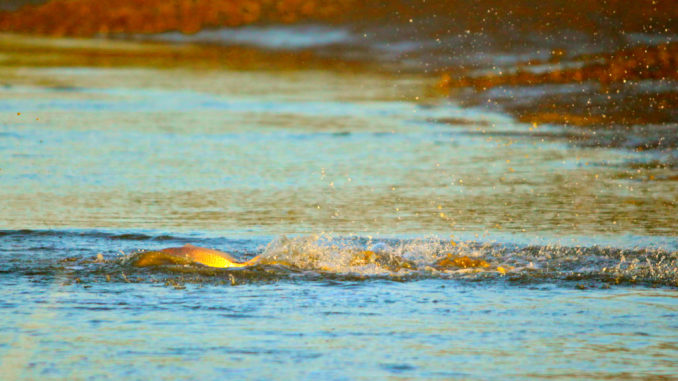
More exciting than reds at the surface? No way
Powerful strikes on top are a thrill. The sight of a fish coming up to chomp on a bait will make even the strongest of hearts skip a beat or two.
This is especially true when the fish is a redfish. Because a redfish’s mouth is positioned near the bottom of its head to more easily feed on prey that’s on the bottom, a red has to position its head above what it’s after to get it in its mouth.
While taking a red on top is possible for much of the year, perhaps no time is better than the fall, when bait is all around and reds are putting the feed bags on.
Capt. John Irwin of Fly Right Charters in Charleston regularly takes reds on top using a variety of lures and flies.
“For hard baits, I like to use a Rapala Skitterwalk, a Heddon Super Spook Jr, or a MirrOlure MirrOdine suspending twitchbait,” he said.
While these lures will catch fish almost any time of day, they work best when there is less light and the water is flowing out of the grass.
“Early or late, when the sun is low, seems to be consistently the best time to take a red on top, especially if its a mid-falling tide” said Irwin, who prefers darker colors in low-light situations; when it’s a little brighter he switches to lighter colors.
Saltwater tackle for fishing topwater with hard baits is much like the tackle used for throwing larger baits to largemouth bass. Medium-action spinning rods and medium-heavy casting rods in 7- to 7 1/2-foot lengths work well. For line, 20-pound braid is pretty much standard for inshore fisherman. but a stiffer leader is needed when using hard baits.
“I use a 30- to 40-pound mono leader, because a stiffer leader helps prevent the line from fouling on the treble hooks,” he said. “Fluorocarbon leaders should be avoided because they sink, which can affect the action of the lure.”
When fishing topwater hard baits, twitching is the key. Simply retrieving the lure like a crankbait or spinnerbait will result in few strikes, but a twitching motion from the rod tip imparting a walk-the-dog action drives fish crazy. It takes a little practice, but once the cadence is down, it is not difficult at all. This is especially important when using a suspending lure like the MirrOdine, because the speed and type of retrieve determines how deep the bait goes.
“I want my twitch baits to suspend only three or four inches below the surface of the water,” Irwin said.
Anytime a strike is visual, fishermen have a tendency to set the hook too quickly and pull the lure away before the fish has it firmly in its mouth. The best way to overcome this problem is not to focus on the strike itself but the feel of the fish. By waiting until you feel the fish before setting the hook, the chance of pulling the bait away too soon is diminished. If that proves too difficult, waiting at least until the lure is no longer visible also works. Inevitably, when fishing on top, a redfish will miss the bait or simply blow it out of the way when they try to get to it. When this happens, it is best to continue to work the bait and not reel in and cast again. Often, a redfish will double back and take another swipe or two at the bait before getting it firmly in its mouth.
Flies also catch reds feeding on top, and they work on a flood tide in the grass, too. Many different surface flies will work, but the best ones often imitate shrimp. Almost everything that swims likes to eat shrimp, and reds are no exception. It is not unusual to see reds busting through a school of shrimp, sending them in every imaginable direction in an attempt to get away. Placing a shrimp fly in the path of a red during the fall when shrimp are thick will often result in an explosive strike.
Irwin ties on a shrimp pattern called the Balsa Wood Shrimp that has proven effective for taking reds on top, and it works well on the flood.
“A lot of times in the grass, especially the tailing fish, (they) will mow that thing down; just give it a couple of pops and let it sit still,” he said.
No matter what you throw at them, topwater reds are a thrill. It’s exciting to catch a redfish, no matter how it is done, but the visual experience of watching a big ’ol red sticking its head up out the water to come crashing down is one that would not be soon forgotten.



Be the first to comment